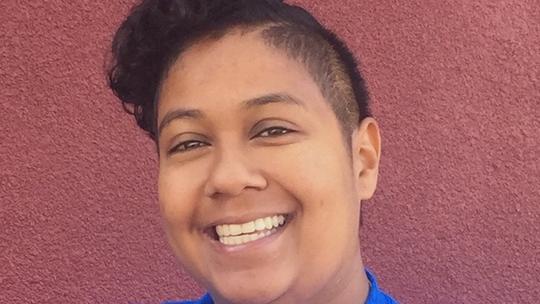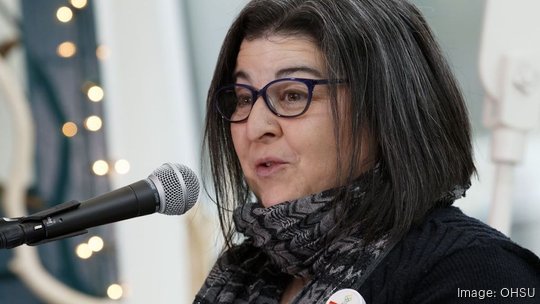Jaiden Love started teaching the essentials of gender identity support in 2018 for the simple reason that such work is needed.
Love, who is a transgender black man, offers trans inclusion training and consulting as a conversation between himself and participants. It’s a learning method that gets the information across but happens on a human-to-human level.
“I’m teaching you the foundational tools on how to interact with trans folks with more compassion and respect. We work on things like pronoun usage and deadnames — because, here is the thing, you have got to understand the basic stuff before you can get into the bigger stuff of how am I going to be more inclusive if you don’t understand how to interact with me,” he said. “How are you going to make sure that I feel included?”
An estimated 1.4 million adults in the United States identify as transgender, or those whose gender identity and expression do not match their sex assigned at birth, according to UCLA-based research group the Williams Institute. The number of trans people and nonbinary people, those whose gender identity or expression is neither male nor female, is expected to rise as younger generations increasingly see gender as fluid.
It’s a demographic shift to which businesses are reacting. In an April 2020 article in the Harvard Business Review, Lisa Kenney, co-founder and CEO of Reimagine Gender, cited the following research:
- More than 12% of U.S. millennials identify as transgender or gender nonconforming
- 56% of the U.S. Gen Z knows someone who uses gender neutral pronouns
- 59% of the U.S. Gen Z thinks forms should include more than “man” and “woman”
- Globally, 25% of Gen Z expects to change their gender identity at least once in their lifetime
Businesses can’t ignore such data from both workforce and consumer perspectives, Kenney wrote.
Love built his consulting practice to help people understand one another.
“Once people can relate and think about it for themselves, they can think about it for others,” he said.
That's critical for creating inclusion.
Transgender people face greater rates of unemployment, underemployment and workplace harassment, according to Basic Rights Oregon, which works to ensure equality for LGBTQ Oregonians. What's more, 250-plus bills in statehouses nationwide look to curb LGBTQ rights, according to Human Rights Campaign. More than 100 of those are aimed at transgender people.
No such bills have been introduced in Oregon, Washington or California. In 2007, Oregon passed the Oregon Equality Act, a comprehensive nondiscrimination piece of legislation, and the Oregon Family Fairness Act, a domestic partnership law.
Interest in diversity, equity and inclusion initiatives has grown in recent years. Basic Rights Oregon offers Fair Workplace Project trainings to help both private and public sector employers “increase their confidence and competence around inviting transgender co-workers onto their staffs and serving transgender clients and customers,” according to BRO.
“I would say DEI work, in general, has been such a hot topic over the past couple of years, due to events that have happened — Black Lives Matter, Covid and understanding the inequities for folks who have not and realizing marginalized communities need to be supported, and they aren’t just going to stand still without action any longer,” said Jo Xavier Doyle, leadership development and training program manager at Basic Rights Oregon.

Since 2016, BRO has given 158 trainings for more than 6,200 people. The nonprofit is on pace to do 50 to 60 more trainings this year.
“There’s a hunger now in the cultural landscape that organizations want to be figuring out how to do this right and are seeking out opportunities to do this learning,” said Kieran Chase, transgender justice program manager at Basic Rights Oregon. “We are not limited by the number of people reaching out but by our capacity.”
What follows are some considerations for employers and employees alike to create gender-affirming workplaces.
Language
Thoughtful and intentional use of gender inclusive language, whether on employment forms or on bathroom doors, can advance an organization's broader diversity, equity and inclusion goals, said Rhodes Perry, founder and CEO of Rhodes Perry Consulting.
Doing so shows that the organization doesn't just welcome trans and non-binary folks, “it’s more like, we had you in mind when we designed this,” he said. “A lot of the work that we do is just trying to make visible what can be invisible for people that just don’t see the barriers that get in the way.”

One way employers can signal their support is to display art by trans artists. Workplaces can also hang posters and PRIDE flags, and host PRIDE events.
“Signaling is one step you can take and make it not performative,” said BRO’s Doyle, who uses the pronouns they/them. “You can have all the policies and the legislation and this positive great backing for rights on paper, but is that being backed up and lived up to in the organization?”
Pronouns are a foundational part of gender inclusive training.
“Pronouns are important because it’s part of our identity,” Love said. “For people to think it’s not a big deal or not a big enough deal to pause or slow down to try to use the right pronouns, it can feel very disrespectful and (that) you are not seeing me as a person.”
And when someone tells you their pronouns, you need to respect whatever they tell you, Love said.
To normalize asking about pronouns, or allow people to share their pronouns if it is safe for them to do so, is one of those inclusive signals, particularly when it comes from cisgender people, or people whose gender identity aligns with the gender and sex assigned at birth.
“If I saw a cisgender person share their pronouns in an email, (it shows they) likely had a conversation, probably with someone who’s trans, about why this is important. And to me that signals they could be a potential ally if I am having trouble in the workplace,” said Perry, who is transgender. While he added it's not always a correct signal, it’s a start for where those looking can seek support.
In addition to adding pronouns to email signatures, other places for normalizing pronouns include sign-in forms, ID badges or even at meetings, with leaders sharing their pronouns and allowing others space to do so as well if they choose.
Perry noted that pronoun sharing shouldn’t be a forced gesture: It might not always be safe for people to do so. Some could also use it as a way to derail a meeting.
This nuance could further cause workers who aren't as familiar with these issues to throw up their hands and give up because it’s hard, Perry said. That's where the work and commitment of DEI and continuous learning come into play.
It’s important to embrace learning rather than perfection, said BRO’s Chase.
“A lot of people get hung up on fear about messing up someone’s pronouns,” Chase said. “It’s hard to stop making assumptions about someone when you first meet them. A key part to this work is giving people permission to make mistakes and not be perfect.”

How we learn
That fear around making a mistake can stymie DEI work and silence conversation and learning.
“We have to recognize that we’re humans, we’re wired to mess up and that we have to be prepared for not if we make a mistake doing this work, but when we make a mistake and to understand what it takes to create the space to start to heal from that rupture,” Perry said.
This means examining how we apologize, how we acknowledge harm, how we listen about harm without getting defensive and what do we do with it. Receiving all of that information with care, then following up with commitments and accountability, is how we learn, Perry said.
It's crucial to bring in experts to lead training and start building organizational muscle around this kind of work. Both Love and Perry noted their work includes asking questions and practicing scenarios that advise how to respond when someone is misgendered, as well as on gender inclusive language.
“I tell people this is the time to mess up, in training,” said Love, adding that even he continues to learn as language and mores evolve. “I am here to help.”
Perry notes that trans and nonbinary folks likely exist in many workplaces, even if their coworkers don't realize it. Taken with the gender views of younger generations, it's imperative employers understand that "the future of work is increasingly nonbinary."
In addition to training, trans and nonbinary inclusive workplaces should establish nondiscrimination policies. However, such policies and training require follow-through work.
“Policies are foundational and aspirational,” Chase said. “Creating a policy that says the workplace doesn’t discriminate against trans people doesn’t necessarily make it true.”
Perry suggests companies looking to build infrastructure for a gender-inclusive workforce start with the Transgender Law Center’s Model Transgender Employment Policy.
Gender affirming health benefits
Dozens of states have initiated legislation in recent years to prohibit gender affirming health care. That’s not the case in Oregon.
Since 2012, the Oregon Department of Consumer and Business Services has prohibited the health plans it regulates from discrimination on the basis of gender identity or gender dysphoria. Essentially, health insurers may not deny or limit coverage or deny a claim for a medically necessary procedure on the basis that it’s provided for gender dysphoria.
“There’s a tremendous stigma, and there are structural barriers that make it hard for those folks to get services,” said Dr. James Polo, medical director for behavioral health at Regence, a Portland-based health insurer.

According to a 2016 DCBS bulletin, Insurers must also cover mental health counseling and gender-affirming treatment for gender dysphoria and should “provide internal training for staff addressing the need to eliminate or avoid any discriminatory action against transgender persons.”
In 2019, the Oregon Legislature placed non-discrimination protections in health insurance that would remain in place even if Congress repealed similar Affordable Care Act protections. DCBS has received only 13 transgender-related health insurance complaints since 2016, mostly relating to the treatments' medical necessity.
As coverage has expanded, providers have scrambled to keep up with demand.
The same month that the OHSU Transgender Health Program officially launched in 2015, Oregon’s Medicaid program began covering gender dysphoria. Around the same time, Medicare lifted a ban on gender care, further stretching limited resources.
“Across the state of Oregon, we immediately found we had a capacity problem, because not only did Medicaid include the diagnosis, but so did more commercial payers, and we did not have the developed programs with infrastructure and centralized referrals,” said Amy Penkin, OHSU Transgender Health Program Supervisor. “Across the country, we saw a lack of preparedness.”
OHSU’s program connects patients to a full array of providers with experience in gender-affirming care for all ages. It served 500 patients during the first year of operation and, by 2019, 4,000 patients from all over Oregon and beyond. Despite adding more providers to the program, wait times for transgender-related surgical procedures can exceed a year.
Since there is no list of specific treatments insurers are required to cover, and research studies are still emerging, coverage gaps persist, especially for procedures some consider “cosmetic” or “aesthetic,” Penkin said. Facial surgery and hair removal are prime examples.

“We advocate for that coverage to be as medically necessary as hormone therapy or genital reconstruction,” Penkin said. “Facial hair may cause the greatest distress as we navigate through the world, since mostly what we’re responding to and interacting with is the face. It’s a significant dysphoria for people.”
Regence draws on guidelines developed by the World Professional Association for Transgender Health. Out of 900,000 Regence enrollees in Oregon, between 500 and 800 have used transgender services since 2018, Polo said.
“What we provide, largely, is dictated by each individual’s experience,” he said. “Classically, folks struggling with transgender issues have a varying degree about how much treatment they want versus how far they’ll go until they feel they can fit into their own communities. The extreme are the individuals who follow through with everything to include surgical options.”
Some services are nonnegotiable, Polo said. Breast removal and phallus construction are fully covered for a transitioning female-to-male, and the reverse is also true for male-to-female patients. But coverage questions for procedures involving personal appearance are often thornier. A hair transplant for male-patterned baldness would likely be covered, but not a tummy tuck.
“The gold standard for helping an individual transition is not 100% about what you or I think they look like, it’s about how does that individual feel about how they fit in and, to some degree, how they’d like others to see them in that gender role,” Polo said.
Other barriers to care include insurers’ preauthorization requirements and provider network for gender-affirming care.
“It’s a good move for Human Resources to do a little digging and find the best providers or resources, and whether they're covered by this health insurance plan or can we find them,” said Basic Rights Oregon's Chase.
Perry noted that businesses have power to select providers and insurers that offer benefits the company deems important.
'I can't believe we are here today'
Perry has done DEI work for nearly 20 years, working with such organizations as Metro, the U.S. Department of the Interior, Nike, LinkedIn and PNC Bank.
When he started, leaders weren’t talking about LGBT inclusion, let alone trans specific inclusion. The broader population wasn’t talking about violence against transwomen or confronting white supremacy culture.
“In some respects, I can’t believe we are here today. That we’re able to have certain conversations, like, we are having a conversation about the murders of black transwomen and pronouns and the role of businesses,” Perry said.
The conversation is elevated partly because a new generation entering the workforce is forcing it: Employees are pushing for recognition of the intersectionality of identities within the workplace. Plus, companies are taking stands publicly, with written statements supporting LGBTQ rights and racial justice.
“For businesses to talk about not just building anti-racist practices or gender inclusive practices, but to confront white supremacy culture, I never thought that would happen,” Perry said.
While increased visibility has led to expanded rights and health coverage, the progress is double-edged, as evidenced by the influx of anti-trans state bills nationwide.
“With this comes an inevitable backlash from people whose worldview is threatened by change and expansion,” Chase said. “That’s unavoidable. There’s nothing someone upset about this can do to stop trans people from existing. We have to push through it and protect ourselves and our families and loved ones and understand that backlash, especially in a polarized environment, is part of the process.”
From a business perspective, it also means companies must follow through with actions on their issued written statements or risk employees walking away to competitors or starting their own businesses.
“What employers fail to recognize is employees see those statements as promises,” Perry said. “Employees are expecting to see actions and when they don’t, we start to see the brain drain of BIPOC employees and trans folks and everybody at the intersections. The status quo is not going to work anymore.”
At the end of the day, everyone, not just the transgender or gender nonconforming employees, benefits.
“When we invest in this work, it impacts positively all of us,” Doyle said. “It makes a better and safer and more affirming workplace for everyone, no matter how they identify. These things do make a difference for everyone to be more comfortable and be their true authentic selves.”



